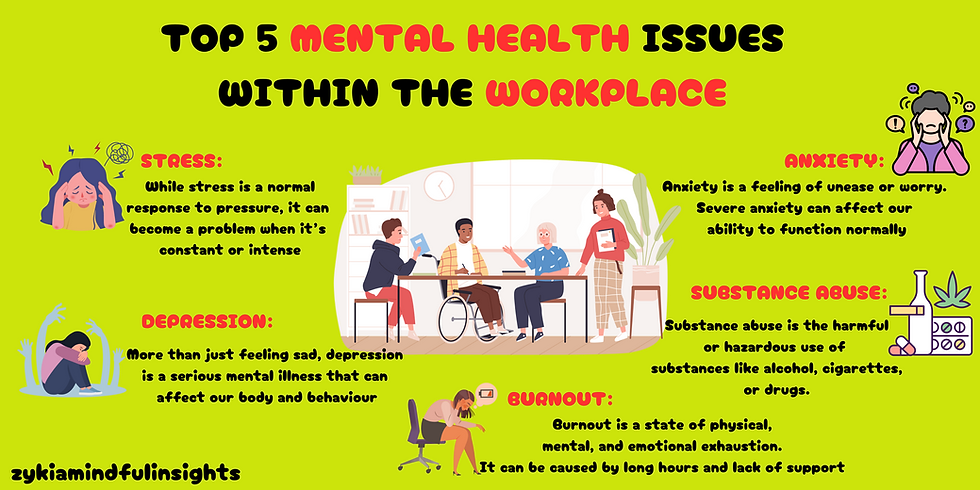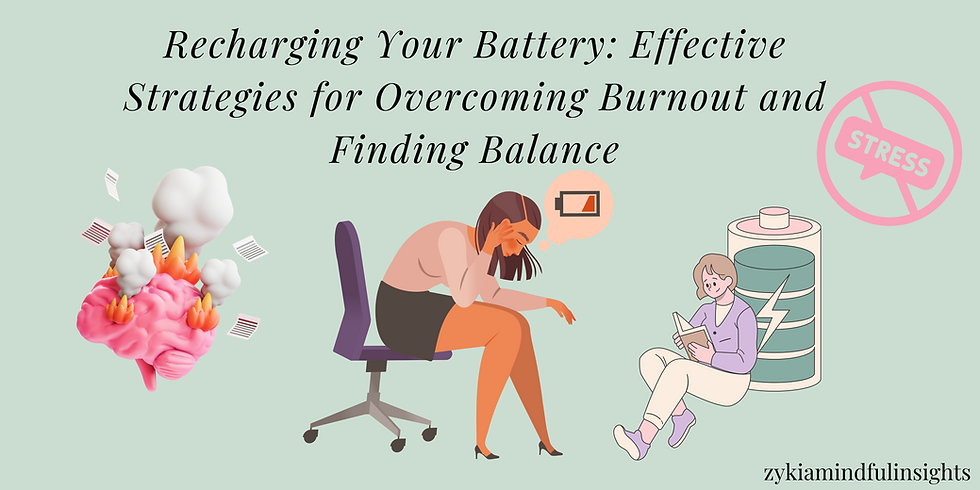Supporting Mental Health in the Workplace: Creating a Healthy Environment
- Zykia Hannah

- Feb 13, 2024
- 5 min read
In today's post, I will be talking about Mental Health in the workplace and how you can create a healthy environment. Supporting mental health in the workplace involves creating a healthy environment by promoting open communication, providing resources for mental health, support, offering flexible work arrangements, encouraging work-life balance, promoting stress management techniques, and fostering a culture of empathy and support among colleagues.

Let's start off with how you can develop your mental health at work.
Developing your mental health at work involves prioritizing self-care and setting boundaries to maintain a healthy balance between professional responsibilities and personal well-being. Start by cultivating self-awareness to recognize stressors and triggers, then implement stress management techniques such as mindfulness or regular breaks to alleviate tension. Seek support from colleagues or professionals if needed, and communicate openly with your manager about workload concerns or the need for flexibility. Actively engage in activities outside of work that bring you joy and relaxation, and strive to foster positive relationships and a supportive environment within the workplace. Regularly assess your mental health and adjust your strategies as necessary to ensure ongoing well-being and resilience in the face of workplace challenges.
"Supporting mental health in the workplace is not only the right thing to do; it's also essential for creating a positive and productive work environment."
Creating a healthy environment to support mental health in the workplace is essential for the well-being and productivity of employees. Firstly, fostering open communication channels is crucial. Encourage employees to express their thoughts, feelings, and concerns without fear of judgment. Establishing regular check-ins with managers or HR can provide opportunities for individuals to discuss any challenges they may be facing and seek support or guidance. Additionally, creating anonymous feedback mechanisms can empower employees to share their experiences and suggest improvements yo promote a more supportive environment.
Secondly, providing access to resources and support services is vital. This includes offering employee assistance programs (EAPs), mental health awareness training, and access to counseling services. Make information about these resources readily available and ensure confidentiality to encourage employees to seek help when needed. By normalizing discussions around mental health and providing tangible support, employees are more likely to feel valued and supported in the workplace.
Thirdly, promoting work-life balance is essential for maintaining mental well-being. Encourage employees to take regular breaks, use their vacation days, and prioritize self-care activities outside of work. Implement flexible work arrangements such as remote work options or flexible hours to accommodate individual needs and responsibilities. By demonstrating a commitment to work-balance, employers can reduce stress levels and foster a culture that prioritizes holistic well-being.
Fourthly, incorporating wellness initiatives into the workplace can contribute to a healthier environment. Organize wellness workshops, yoga classes, or meditation sessions to promote relaxation and stress management techniques. Encourage physical activity by offering gym memberships or organizing team sports activities. By investing in employee wellness, employers demonstrate a commitment to their employees' overall health and happiness.
Fifthly, fostering a culture of inclusion and belonging is essential for supporting mental health. Promote diversity and equity initiatives, provide training on unconscious bias and micro-aggressions, and create opportunities for employees to connect and build relationships across different teams and backgrounds. By fostering an inclusive culture where everyone feels valued and respected, employers can help mitigate feelings of isolation and promote a sense of belonging.
Lastly, lead by example by prioritizing mental health and well-being at all levels of the organization. Encourage leadership to openly discuss their own experiences with mental health challenges and the strategies they use to cope. Implement policies and practices that prioritize employee well-being, such as flexible scheduling, mental health days, and access to mental health resources. By demonstrating a commitment to supporting mental health in the workplace, employers can create a culture where employees feel empowered to prioritize their own well-being while contributing to a healthy and thriving work environment.

"An inclusive workplace is one where mental health is prioritized, and everyone feels valued and supported."
Coping with supporting mental health in the workspace and creating a healthy environment involves several strategies:
Self-care: Encourage employees to prioritize self-care activities such as exercise, proper nutrition, sufficient sleep, and relaxation techniques. Promote the importance of taking breaks during the workday to recharge and manage stress effectively.
Establish Boundaries: Help employees set clear boundaries between work and personal life to prevent burnout. Encourage the to disconnect from work-related communication outside of working hours and utilize their vacation days to rest and rejuvenate.
Promote Mental Health Awareness: Offer workshops, seminars, or training sessions to educate employees about mental health issues, seeking help, and provide information about available resources such as counseling services or support groups.
Encourage Open Communication: Foster a culture of transparency and trust where employees feel comfortable discussing their mental health concerns with managers or colleagues. Encourage active listening and empathy to create a supportive environment where individuals feel valued and understood.
Flexibility: Offer flexible work arrangements such as remote work options, flexible hours, or compressed workweeks to accommodate employees' varying needs and preferences. This can help reduce stress levels and improve work-life balance.
Provide Resources: Ensure that employees have access to mental health resources and support services, such as employee assistance programs (EAPs), counseling services, or mental health hotlines. Make information about these resources easily accessible and promote their use as needed.
Lead by example: Demonstrate leadership's commitment to supporting mental health by modeling healthy behaviors, prioritizing work-life balance, and openly discussing mental health issues. Encourage managers to check in regularly with their team members and provide support and guidance as needed.
Create a Positive Work Environment: Foster a positive and inclusive workplace culture where diversity is celebrated, and individuals feel respected and valued. Recognize and reward employees for their contributions, and promote teamwork and collaboration.
By implementing these coping strategies, organizations can create a supportive and healthy work environment that prioritizes employees' mental health and well-being.
In this next section, I will be providing some facts about Mental Health in the Workplace and Creating a Healthy Environment:
Companies that prioritize mental health in the workplace experience higher employee engagement, productivity, and retention rates.
Mental Health issues cost employers billions of dollars annually in absenteeism, presenteeism, and healthcare expenses.
Flexible work arrangements, such as remote work options and flexible hours, can significantly improve employees' mental well-being and work-life balance.
Providing access to mental health resources and support services, such as employee assistance programs (EAPs) and counseling services, is crucial for supporting employees' mental health needs.
Creating a physically safe and comfortable work environment, with adequate lighting, ventilation, and erogonomic furniture, can positively impact employees' mental health.
Regularly evaluating the effectiveness of mental health initiatives and soliciting feedback from employees can help identify areas for improvement and ensure ongoing support for mental health in the workplace.

In conclusion, supporting mental health in the workplace and creating a healthy environment is not just a moral imperative but also a strategic investment in the well-being and success of employees and the organization as a whole. By prioritizing mental health awareness, providing access to resources and support services, promoting work-life balance, fostering open communication, and cultivating a culture of empathy and inclusion, employers can create environments where employees feel valued, supported, and empowered to thrive. It is through these collective efforts that we can build workplaces that prioritize the mental health and well-being of every individual, ultimately leading to happier, healthier, and more productive teams.
That concludes today's blog post. i hope you all enjoyed reading this post today. Today is also a very special day today because it's my 22nd birthday today🥳!!!! Once again thank you all so much for supporting me and loving my post, I really appreciate it so much. This means the world to me🤍. As always make sure to leave feedback below and like the post. Thank you 🩷🙏🏾
🫧Quote of the day:
"When employees feel valued, supported, and heard, they are more engaged, productive, and loyal to their organization."🤍




コメント